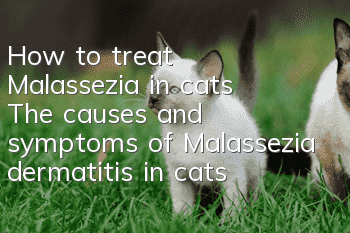How to treat Malassezia in cats? The causes and symptoms of Malassezia dermatitis in cats!

Malassezia dermatitis in cats
How to treat Malassezia dermatitis in cats? The causes and symptoms of Malassezia dermatitis in cats! Malassezia dermatitis in cats is usually caused by excessive Malassezia Proliferation is common clinically and is often caused by other underlying diseases or is complicated by other skin diseases. This disease is a classic example of pruritus, which is completely different from the symptoms of ringworm, which is a classic cause of alopecia.
Malassezia is a thick-walled single-celled yeast. Single-celled Malassezia are generally oval, round or cylindrical. The cells form a "peanut" shape as they bud. Malassezia can be passed to the pups through the mother's reproductive tract, or through postpartum licking and grooming. Healthy animals mostly have Malassezia in the ear canals, anal glands, between the fingers, and at mucocutaneous junctions (lips, foreskin, vagina, and anus). Other parts of the body will not appear. Malassezia stored in mucous membranes can be spread to the skin through licking or grooming.
Malassezia may colonize the superficial layers of the skin epidermis and the stratum corneum in the infundibulum area of hair follicles. Malassezia forms a symbiotic relationship with epidermal Staphylococcus aureus. Together, they create mutually beneficial growth factors and a good microenvironment. Pyoderma is often found to be complicated by Malassezia dermatitis. Therefore, controlling the number of bacteria during treatment is more effective than antifungal treatment alone.
1. Epidemiology
In a balanced state, Malassezia pachyderma is a symbiotic bacterium in healthy animals, living on the surface of keratinocytes and peeling off skin. , the antifungal effect of epidermal lipids and non-specific defense mechanisms (such as serum IgA) prevent excessive proliferation and infection. Malassezia has a symbiotic relationship with commensal Staphylococcus aureus, and Malassezia dermatitis is often complicated by bacterial overproliferation or pyoderma. Therefore, controlling the number of bacteria during treatment is more effective than antifungal treatment alone.
2. Pathogenesis
1. Conditional pathogens
a. When the host defense mechanism (physical, chemical, immune) is damaged , value added and infection increased.
b. For example: atopic dermatitis, other allergies, endocrinopathy, keratinization defects, immunosuppression (FIV/FELV), previous antibiotic treatment, excessive humidity, skin wrinkles, chronic diabetes Corticosteroid therapy.
2. Destruction of the stratum corneum
a. Itchy damage (allergy).
b. Biochemistry: moisture, immune abnormalities, keratinization defects lead to lipid changes on the skin surface, and endocrinopathy.
C. Yeast and bacterial enzymes (esterase, lipoxygenase, protease, urease).
3. The immune system is exposed to Malassezia antigens and products.
4. Malassezia dermatitis/hypersensitivity reaction.
Malassezia secretes various enzymes to change the pH value of the skin, activate complement and release inflammatory mediators, making the microenvironment of the skin more suitable for the survival of Malassezia and Staphylococcus aureus, and creating inflammation and itching.
The warm and moist microenvironment created by special parts of the host skin (skin folds, hanging lips, hairy feet), inflammation, exudation, self-licking, etc. is particularly suitable for Malassezia. Keratinization defects and endocrinology can also increase humidity and alter the quantity and quality of sebum. However, the relationship between sebum production and Malassezia proliferation remains unclear. In addition, defects in self-scratching, keratinization, or metabolism may allow Malassezia to establish a basis for proliferation.
3. Clinical symptoms
1. Erythema, yellow flakes and scabs, greasy and foul-smelling skin.
2. Face, feet, ventral neck, abdomen, between fingers, nail bed, skin folds.
3. Otitis with yellow or brown discharge.
4. Itching
Systemic infections, ear infections, paronychia and chin acne, devincos and sphynx may be seen in tumors and severely diseased cats Cats are susceptible.
4. Treatment plan
Malassezia dermatitis is closely related to the cat’s own resistance, so it is important to strengthen nutrition and you can give it Eat some boiled fish and nutritional paste. Give it a bath with a medicinal bath, the recommended one is Piyankang.
In addition, shampoos can be used for external treatment: chlorhexidine 2%, enconazole 2%; selenium sulfide; ketoconazole; piroctone, ccipirox ethanolamine with monosaccharide. Or take it orally:
1. Ketoconazole: 5-10mg/kg, take with food for 14-28 days, there may be side effects
2. Itraconazole : 5mg/kg, less side effects, more expensive, can be taken once a week and stopped within a week 3. Terbinafol: 30-40mg/kg.
- What does it mean when a cat lies down and his belly is turned out?
- How many meals do cats need to feed a day?
- Causes and treatment of urinary tract stones in cats
- What are the advantages and disadvantages of British Shorthair blue cats?
- Why is the female cat not in heat?
- What are the games about cats? Four games that cats like!
- What should I do if my cat is in a bad mood?
- How to train a cat to remember its own name? It’s actually very simple!
- Five tips to train a cat and make it stop scratching and biting!
- What should you pay attention to when adopting a stray cat? How to deal with stray cats?



